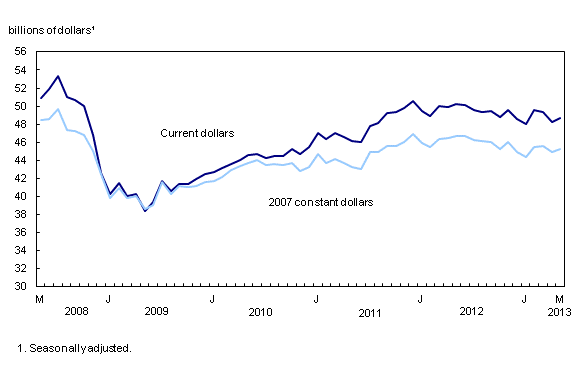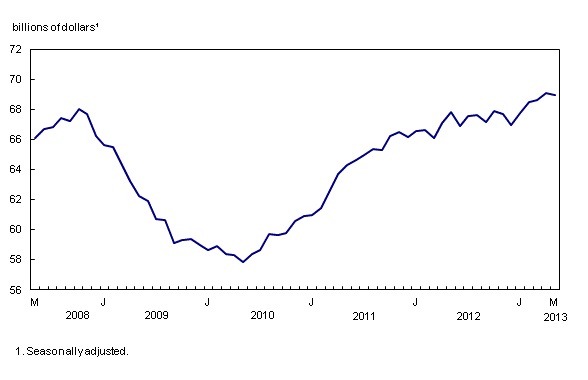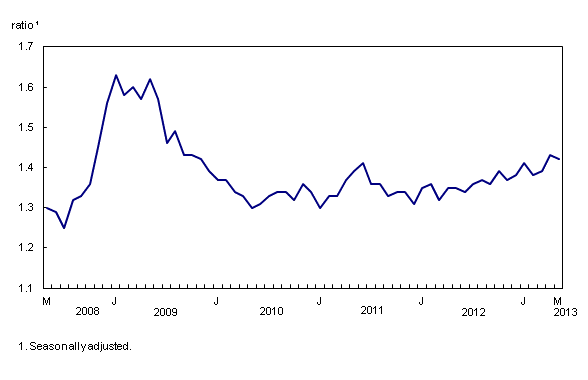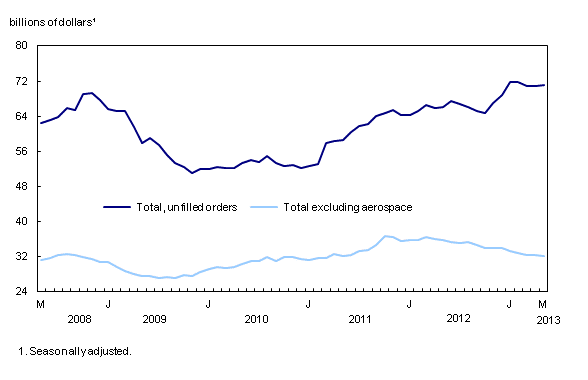Monthly Survey of Manufacturing, May 2013
Archived Content
Information identified as archived is provided for reference, research or recordkeeping purposes. It is not subject to the Government of Canada Web Standards and has not been altered or updated since it was archived. Please "contact us" to request a format other than those available.
Released: 2013-07-16
Manufacturing sales increased 0.7% to $48.6 billion in May, the second gain in five months.
Sales were up in 11 of 21 industries, representing about 57% of the manufacturing sector. Sales of durable goods were up 1.3% while non-durable goods sales edged up 0.2%.
Constant dollar sales increased 0.7% as volumes rose.
Chemical manufacturing leads the gains
The chemical industry posted the largest sales gain in dollar terms. Sales in the industry were up $195 million to $4.0 billion, the 8th increase in 12 months. The gain in May mainly reflected a larger than usual increase in fertilizer sales. Wetter and colder weather this year delayed spring planting. Hence, the annual ramp-up in fertilizer production occurred later this year than in previous years.
Sales of primary metals rose 4.0% in May to $3.5 billion, partially rebounding from a 9.1% drop in April. In the machinery and fabricated metal products industries, sales increased 3.8% and 3.4% respectively. In all three industries, higher volumes of products sold were responsible for the gains.
A 4.8% decline in sales to $2.1 billion in the wood product industry offset some of the sales increases. The decrease followed seven months of advances. Notwithstanding the decline, wood product sales were 26.5% higher compared with May 2012.
Sales in the food industry were down 1.3% to $7.3 billion in May, the lowest level since November 2012.
Sales gains led by Ontario
Sales were up in six provinces, led by Ontario, Alberta and Saskatchewan.
In Ontario, sales rose 1.9% to $22.7 billion, reaching their highest level since November 2012. The gain mainly reflected increases in the petroleum and coal product (+8.7%), motor vehicle assembly (+2.0%), and chemical (+3.9%) industries.
Sales in Alberta advanced 2.1% to $6.2 billion. The increase was caused by higher sales in the petroleum and coal product (+5.8%) and chemical (+7.5%) industries.
Saskatchewan manufacturers reported a 5.8% rise in sales. The gain mainly reflected increases in the non-durable goods industries.
In Quebec, sales fell 2.8% to $10.7 billion, the 10th decline in 12 months. This decrease stemmed from lower sales in the petroleum and coal product industry. In May, Quebec manufacturing sales were at their lowest level since September 2009.
Inventories edge down
Inventories edged down 0.2% to $69.0 billion, the first decline after four months of gains. In the primary metal industry, inventories were down 3.3% to $7.4 billion. Lower inventories of paper (-2.3%) and non-metallic mineral products (-3.8%) also contributed to the decline in total inventories.
However, a 2.5% advance in goods-in-process inventories in the aerospace product and parts industry partly offset the declines. In addition, total inventories were up in the chemical (+1.3%) and computer and electronic product (+1.8%) industries.
The inventory-to-sales ratio decreased slightly to 1.42 in May from 1.43 in April. The values for the ratio in April and May were the highest since the autumn of 2009.
Unfilled orders rise
Unfilled orders increased 0.6% to $71.2 billion, as a result of gains in the transportation equipment industry. Unfilled orders were also up in the primary metal industry.
The increase in unfilled orders for transportation equipment reflected a 1.2% advance in the aerospace product and parts industry. Aerospace unfilled orders reached $39.0 billion in May, the highest level ever recorded for the industry. Unfilled orders also rose in the ship and boat building industry.
In the primary metal industry, unfilled orders rose 8.3% to $1.3 billion. The gain was the largest since November 2011.
A portion of the gains in total unfilled orders was offset by a 1.9% decline in the machinery industry.
New orders increased 1.8% to $49.0 billion in May. The increase reflected gains in the transportation equipment, primary metal, fabricated metal product and chemical industries.
Note to readers
Monthly data in this release are seasonally adjusted and are expressed in current dollars unless otherwise specified.
Non-durable goods industries include food, beverage and tobacco products, textile mills, textile product mills, clothing, leather and allied products, paper, printing and related support activities, petroleum and coal products, chemicals, and plastics and rubber products.
Durable goods industries include wood products, non-metallic mineral products, primary metal, fabricated metal products, machinery, computer and electronic products, electrical equipment, appliances and components, transportation equipment, furniture and related products and miscellaneous manufacturing.
Production-based industries
For the aerospace industry and shipbuilding industries, the value of production is used instead of sales of goods manufactured. This value is calculated by adjusting monthly sales of goods manufactured by the monthly change in inventories of goods in process and finished products manufactured.
Unfilled orders are a stock of orders that will contribute to future sales assuming that the orders are not cancelled.
New orders are those received whether sold in the current month or not. New orders are measured as the sum of sales for the current month plus the change in unfilled orders from the previous month to the current month.
Data from the June Monthly Survey of Manufacturing will be released on August 16.
Contact information
For more information, contact us (toll-free 1-800-263-1136; infostats@statcan.gc.ca).
To enquire about the concepts, methods or data quality of this release, contact Michael Schimpf (613-951-9832; michael.schimpf@statcan.gc.ca), Manufacturing and Energy Division.
- Date modified:





